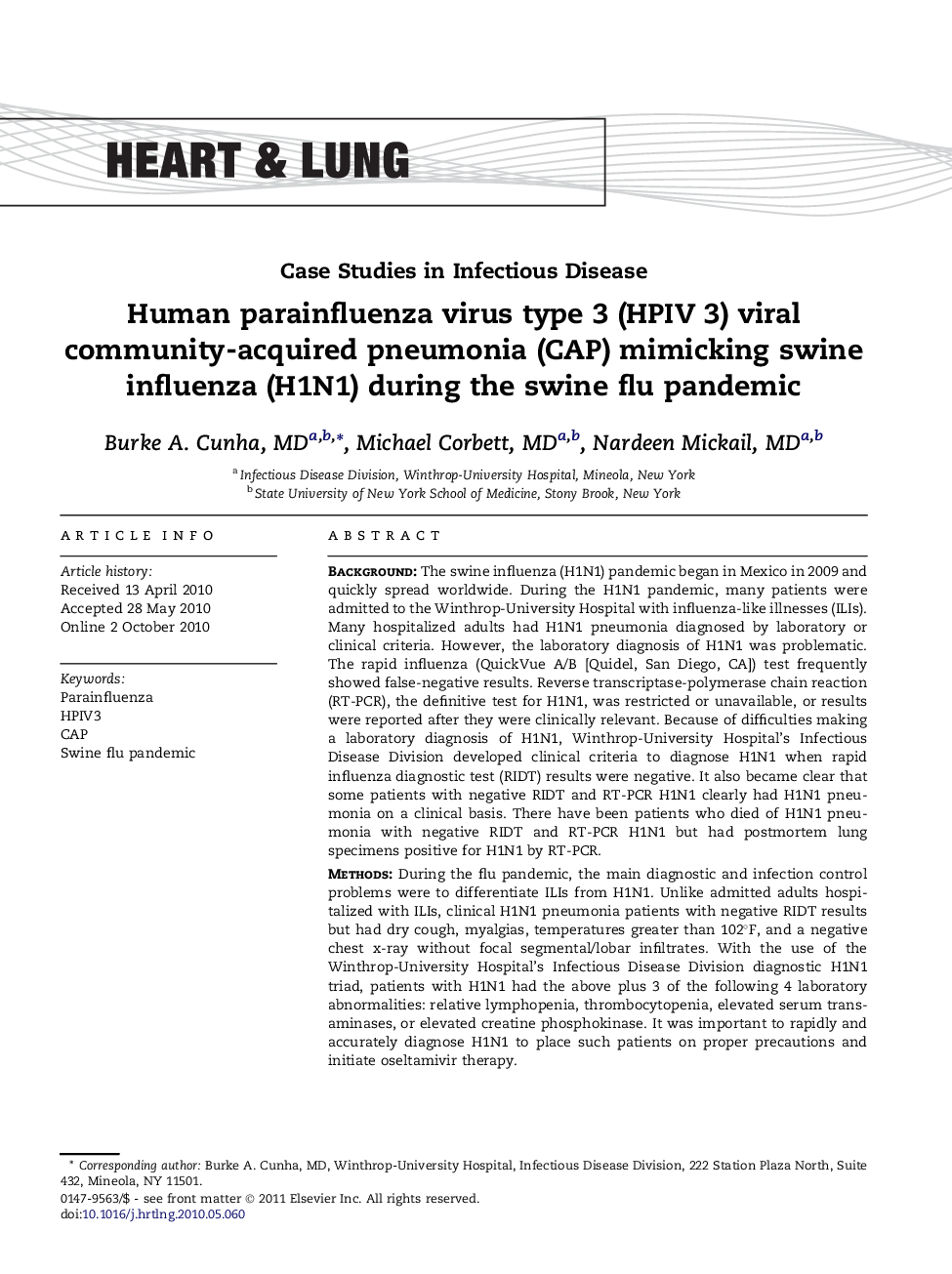| کد مقاله | کد نشریه | سال انتشار | مقاله انگلیسی | نسخه تمام متن |
|---|---|---|---|---|
| 2650945 | 1139432 | 2011 | 5 صفحه PDF | دانلود رایگان |

BackgroundThe swine influenza (H1N1) pandemic began in Mexico in 2009 and quickly spread worldwide. During the H1N1 pandemic, many patients were admitted to the Winthrop-University Hospital with influenza-like illnesses (ILIs). Many hospitalized adults had H1N1 pneumonia diagnosed by laboratory or clinical criteria. However, the laboratory diagnosis of H1N1 was problematic. The rapid influenza (QuickVue A/B [Quidel, San Diego, CA]) test frequently showed false-negative results. Reverse transcriptase-polymerase chain reaction (RT-PCR), the definitive test for H1N1, was restricted or unavailable, or results were reported after they were clinically relevant. Because of difficulties making a laboratory diagnosis of H1N1, Winthrop-University Hospital’s Infectious Disease Division developed clinical criteria to diagnose H1N1 when rapid influenza diagnostic test (RIDT) results were negative. It also became clear that some patients with negative RIDT and RT-PCR H1N1 clearly had H1N1 pneumonia on a clinical basis. There have been patients who died of H1N1 pneumonia with negative RIDT and RT-PCR H1N1 but had postmortem lung specimens positive for H1N1 by RT-PCR.MethodsDuring the flu pandemic, the main diagnostic and infection control problems were to differentiate ILIs from H1N1. Unlike admitted adults hospitalized with ILIs, clinical H1N1 pneumonia patients with negative RIDT results but had dry cough, myalgias, temperatures greater than 102°F, and a negative chest x-ray without focal segmental/lobar infiltrates. With the use of the Winthrop-University Hospital’s Infectious Disease Division diagnostic H1N1 triad, patients with H1N1 had the above plus 3 of the following 4 laboratory abnormalities: relative lymphopenia, thrombocytopenia, elevated serum transaminases, or elevated creatine phosphokinase. It was important to rapidly and accurately diagnose H1N1 to place such patients on proper precautions and initiate oseltamivir therapy.ResultsAs the H1N1 pandemic progressed, it became clear that there were some infectious diseases that mimicked H1N1 pneumonia (eg, Legionnaires’ disease). We describe the case of a 61-year-old man who presented with an ILI with dry cough, fever, myalgias, and shortness of breath. His rapid influenza A test result was negative, and specimens for RT-PCR for H1N1 were ordered. On admission, he had relative lymphopenia, thrombocytopenia, and an elevated creatine phosphokinase. His chest x-ray showed no focal segmental or lobar infiltrates. The patient was placed on influenza precautions and administered oseltamivir. During the patient’s hospital course, the RT-PCR for H1N1 was reported negative. His respiratory fluorescent antibody viral panel was negative for influenza A, influenza B, metapneumoviruses, respiratory syncytial virus, and adenoviruses but positive for human parainfluenza virus type 3 (HPIV 3).ConclusionsClinicians should be aware of other causes of community-acquired pneumonia that may mimic H1N1 pneumonia. In our experience, the most common mimics of H1N1 pneumonia are Legionnaires’ disease or HPIV 3 in adults, and metapneumovirus or respiratory syncytial virus in children. In adult patients who present with an ILI and negative RIDT results, we suggest that respiratory secretions specimens be obtained for respiratory fluorescent antibody viral testing pending RT-PCR for H1N1 results. HPIV 3, known to be an important community-acquired pneumonia pathogen in transplant recipients and immunosuppressed patients, is also an important pathogen in immunocompetent adults. In normal adult hosts, the clinical presentation of HPIV 3 pneumonia may clinically closely mimic H1N1 pneumonia.
Journal: Heart & Lung: The Journal of Acute and Critical Care - Volume 40, Issue 1, January–February 2011, Pages 76–80